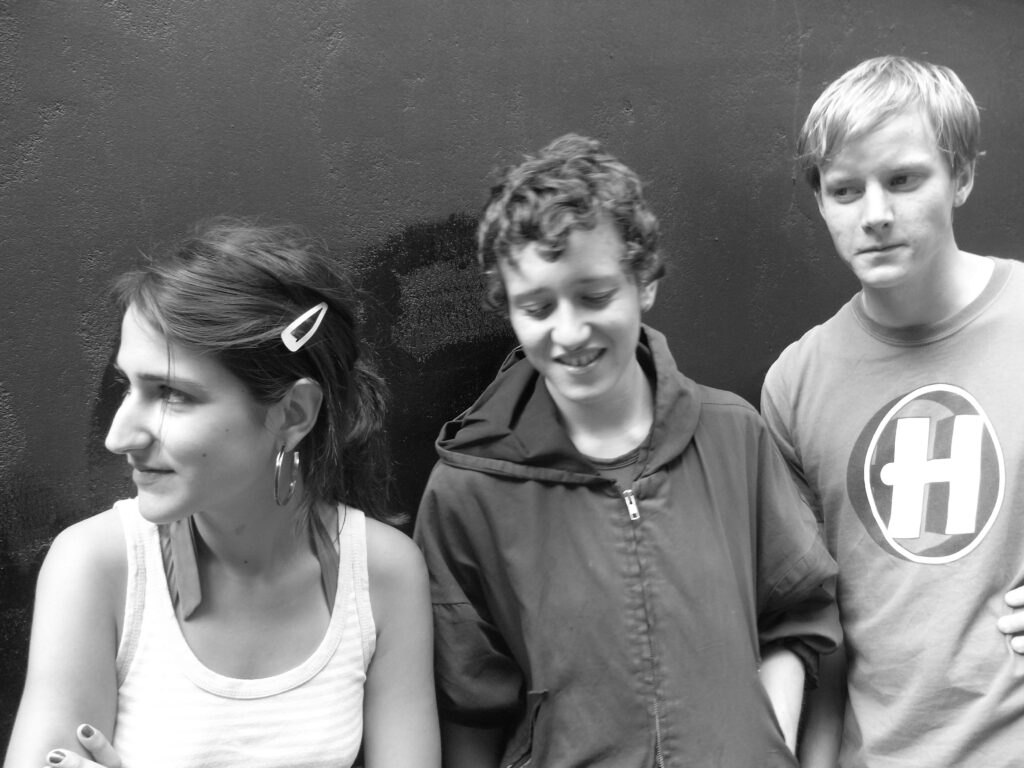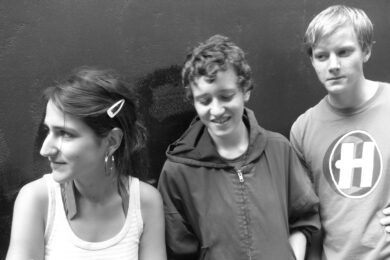After 2009’s ground-breaking debut Jewellery, East London trio Micachu & The Shapes return with Chopped & Screwed, an album created from a concert they performed with the prestigious London Sinfonietta last May. The collaboration played to Mica Levi’s musical education (although she describes herself as primarily a “beat-maker”) – she studied composition at the Guildhall School of Music and Drama.
In approaching the project, however, Mica employed her love of hip hop and in particular, the technique of chopping and screwing – pioneered by Houstonite DJ Screw in the 1990s – to slow down and warp particular instruments. The results are pretty extraordinary – Chopped & Screwed is hugely ambitious, with both band and orchestra pushed into new sonic territory.
The project was initiated by the Sinfonietta’s Chief Executive, Andrew Burke after he attended an acoustic gig by The Shapes. “I had been told about Mica’s background at Music College and knew that she had already written really interesting pieces for acoustic classical players,” he told me when I asked him what initially sparked his interest. “Sometimes it can be hard to hear how a collaboration may work between a band and the London Sinfonietta, but their music was inventive, experimental and different and it seemed an exciting idea to see if they would come and work with us.”
Andrew is delighted with the resultant album, “In any of these projects I don’t want the Sinfonietta to become a backing band – just realising a pre-recorded orchestral track with a trendy pop band. With Micachu & The Shapes we truly collaborated and made new material together, led by Mica and the band. That kind of project is a good example of how we like to work.”
I met up with Mica in a Shoreditch bar. We were both early and the only punters in the establishment. She is quiet and thoughtful – not a natural extrovert. As you might expect, for someone whose work already covers a range of styles and instruments (including a number of homemade devices), she is hugely seduced by different forms of music. At one point during the interview, Mica rushes off to find her laptop because she wanted to play me her “favourite new song” – Sun Ra’s ‘When There Is No Sun’.
I believe the offer of a collaboration with the London Sinfonietta came via Andrew Burke. Were you initially excited by the idea?
Mica Levi: Definitely – it was amazing to be asked by a really great, established orchestra.
You have trained in classical music. Did this make it easier to approach how to develop music with them?
ML: I studied at college – I did composition – and the ensemble was playing music that I had been taught about. To work with them is an honour, really. I think they hoped that I would have a sensitivity about the two things, the two kinds of forces – it is so difficult to blend the worlds [of classical and popular music] into one culture. One thing – the band – is about you and your personalities and your ideas. The other thing is a group of people who are very able to read instructions correctly and effectively. Their taste and opinion is sort of irrelevant.
So, how did you go about creating the music that would become Chopped & Screwed?
ML: Firstly, we had to lock down a group, instead of it just being us and a load of musicians, we thought it would be important to meet somewhere in the middle. Classical music requires attention. The nearest thing from that to what we do is probably folk [music] in terms of people just listening to someone playing. I tried to think about that to make a smallish band, so we chose nine instruments and then we asked for those nine musicians. Then we had a workshop day and me, [drummer] Marc [Pell] and [keyboard player] Raisa [Khan] wrote down some ideas and came with some bits, and I notated some bits of texture, and we talked to the nine Sinfonietta musicians about sounds.
Then, we went away on tour in the States and I had to write it quickly. So, I just wrote a load of songs in the van and then we got stranded by the unpronounceable volcano. It was stressful – we were trying to use notation software but it was demos off the internet. The one thing I got taught at college was to be neat and clear with your notation.

Regardless of being stranded, I can imagine there was quite a lot of pressure on you to deliver a piece of music to such a revered orchestra?
ML: It was pressured – it was so stressful, I can’t even tell you. I was going to do a runner. We did the run through before the concert and I was thinking of where I could run away to and how much it would cost to recoup the money. Is it better to make a fool out of yourself? Or is it best to run away? I shouldn’t have even told you I was thinking of that.
Jeepers – it seems to have worked out pretty well. The album is called Chopped And Screwed, a reference taken from a genre of hip-hop pioneered by people like DJ Screw. Could you explain a bit more about ‘chopping and screwing’ and why it inspired your collaboration?
ML: It’s just the kind of imagination of it. By using CD machines and using vinyl to slow things down, a whole genre of hip hop was created that sounds so weird. The ‘being screwed’ is by having things slow and fugged out. You’ve got a single that is meant to be played at 45 [rpm] and you play it at 33 with the pitch arm down really low, so it sounds just dirgey. The ‘chopping’ is just cutting loops and editing – chops happen in all kinds of hip-hop, I suppose. You’ve gotta remember I’ve been making beats since ever since when. That’s how I started this whole thing.
And what has Purple Drank [a codeine-based cough syrup] got to do with chopping and screwing?
ML: Yeah, the drug of choice that goes with that music is cough syrup and so there are some lyrics that are about that – people falling over and stuff. Basically, the chopping and screwing thing helped in terms of coming up with some barriers because the project could have been anything and endless. A lot of other things that came into it are not just hip-hop but psychedelic prog-rock type things. You can’t deny that getting a band to play with a classical orchestra is trying to embrace that. There is something psychedelic about slowing things down and being warped and crazy. So, it was more of a speed thing.
So, how did these classically-trained musicians in the Sinfonietta react to your ideas?
ML: There was this one lady called Joan and she was in the first ever Sinfonietta performance 40-years ago. She said some amazing things. There is this thing called ‘scratch tones’; when you press really hard on the bridge of a string instrument it makes a really harsh sound and we wanted everyone to loop that sound. Anyway, it sounded a bit horrific – it was half-notated and half-led. Joan would say things like ‘this sounds a bit weird’. This lady has being playing avant garde music – the weirdest shit you have ever heard – for 40-years!
Do you think the Sinfonietta musicians enjoyed the experience?
ML: I think that everyone felt we were in it together and that was, in part, what we were aiming for. Everyone was nervous together and everyone was quite buzzing afterwards.
How did the idea come about to put the live concert out as an album?
ML: Initially, we weren’t even thinking of putting it out as an album. There was a mix of the concert and I took the stems and did a bit more mixing, to see how I felt about it. I dunno, it sounded alright in the end. You gotta keep putting things out or you would never put anything out. Some people will like it and some people won’t. You keep making things and can’t hold onto everything for yourself. Well, I guess you can, but that is a career decision.
You’ve also made a mix-tape to accompany the album. What was the inspiration for that?
ML: I guess it made sense to, really. It is not that slow actually, a lot of the tracks are kind of dubstep speed – 140 [bpm] or whatever – and I’ve taken it down to 130. I sampled each track and then used a hip hop kit. I then went to a really old friend’s [Brotha May] house and got him to freestyle over it. I gave him the subject matter of each song – falling down, drinking too much, wasting time, the State of New York – and he just freestyled it. It was really impressive actually.
There is a sense that Chopped & Screwed was opportunistic – a chance to collaborate with the Sinfonietta. Have you any idea what the next, perhaps more planned, Micachu & The Shapes album might sound like?
ML: At the moment it is sounding pretty much like a guitar record. I started writing with the band on the guitar and when you write with a guitar it sounds like guitar music. We will see what happens. I been listening to loads of The Beatles and it might be nice to make a record with just guitars. If you can spread your sound over a number of mediums, it is nice to put them in little collections. It might be nice to do a little record of guitar songs.
Your debut album Jewellery was a hugely experimental set of songs, and now your second album is a collaboration with a classical orchestra. So, what is at the core of the Micachu & The Shapes sound?
ML: Everyone in the band is a beat-maker, primarily, I’d say. Together, we are a live band and there are all these bits in the middle. I can’t be hardcore on one thing. What is nice about working with Marc and Raisa is that they are up for anything. Hopefully, underneath it all is what I aspire to do – write good songs. However you dress it up, whatever style or speed or texture, a good song is a good song and a bad song is a bad song. That’s how it is. I know it is a bit lazy to say that.
And finally, would you like to work with the Sinfonietta again?
ML: Yes, absolutely, there is always something nice about getting onstage at somewhere prestigious, and having a sense of humour about it, it is quite surreal. You feel a bit rebellious – that was a nice thing to have happen.
Chopped & Screwed is out now on Rough Trade



